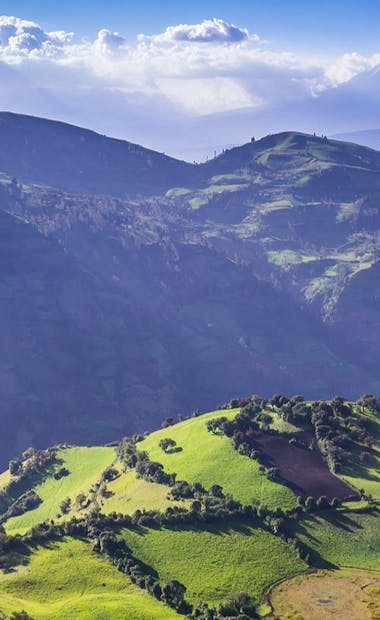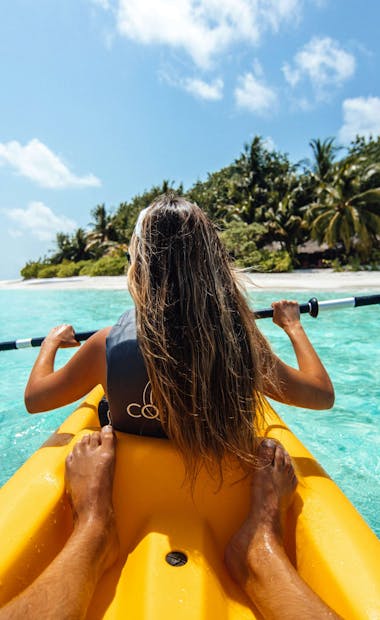
Ecuador Tours
Climb volcanoes, explore the Amazon and follow in Darwin's footsteps in the Galapagos
Popular tours
- Save26%
 View Tour
View TourGalápagos Express Adventure: Wilderness & Wildlife - 7 Days
- Santa Cruz Island to Puerto Baquerizo Moreno
- Age group: 18 - 39
- Max group size: 16
Was:£1,029From£764 - Save26%
 View Tour
View TourGalápagos Adventure: Snorkelling & Sea Lions - 9 Days
- Quito to Quito
- Age group: 18 - 39
- Max group size: 16
Was:£1,579From£1,172 - Save26%
 View Tour
View TourLocal Living Ecuador—Amazon Jungle - 7 Days
- Quito to Quito
- Age group: 12 - 100
- Max group size: 16
Was:£649From£482 - Save26%
 View Tour
View TourEcuador Multisport - 9 Days
- Quito to Quito
- Age group: 12 - 100
- Max group size: 16
Was:£949From£705 - Save26%
 View Tour
View TourHighlands of Ecuador - 8 Days
- Quito to Quito
- Age group: 12 - 100
- Max group size: 16
Was:£899From£668 - Save26%
 View Tour
View TourGalápagos Multisport - 10 Days
- Quito to Quito
- Age group: 12 - 100
- Max group size: 16
Was:£2,629From£1,952
Ecuador Tours
Welcome to Ecuador, a captivating country that offers a myriad of enchanting experiences for travelers seeking adventure, natural beauty, and cultural immersion. Embark on an unforgettable journey through Ecuador's diverse landscapes, from the lush Amazon rainforest to the breathtaking Andes Mountains and the pristine Galapagos Islands. With our carefully curated Ecuador tours and holidays, you can explore this vibrant destination like never before.
Ecuador, situated in the heart of South America, is a hidden gem that boasts an incredible array of attractions. Let us take you on a virtual tour of this captivating country, showcasing its main highlights and providing you with a glimpse of why it should be at the top of your travel bucket list.
1. The Galapagos Islands: A true natural wonder and a UNESCO World Heritage site, the Galapagos Islands offer a unique opportunity to witness a pristine ecosystem teeming with extraordinary wildlife. Dive into crystal-clear waters to swim alongside playful sea lions, snorkel with colorful tropical fish, and encounter ancient giant tortoises that roam freely. These islands, famously visited by Charles Darwin, will leave you in awe of their remarkable biodiversity and untouched beauty.
2. The Amazon Rainforest: Immerse yourself in the heart of the Amazon, one of the world's most biodiverse regions. Trek through lush jungles, listening to the mesmerizing sounds of exotic birds and monkeys. Discover indigenous communities and learn about their ancient traditions and deep connection to the rainforest. Explore the winding rivers by canoe, spotting caimans, pink river dolphins, and vibrant bird species. A journey through the Amazon is a transformative experience that will ignite your sense of adventure and appreciation for the natural world.
3. The Andes Mountains: Prepare to be amazed by the stunning landscapes of the Andes Mountains, where snow-capped peaks, majestic volcanoes, and picturesque valleys paint a breathtaking backdrop. Hike through scenic trails, passing by quaint villages and encountering friendly locals who warmly welcome you into their traditions and way of life. The Andes offer countless opportunities for outdoor enthusiasts, from climbing towering peaks to trekking to hidden lagoons and exploring vibrant markets brimming with indigenous crafts.
4. Colonial Cities: Step back in time as you wander through Ecuador's charming colonial cities. Quito, the capital, showcases a well-preserved historic center, filled with elegant churches, grand plazas, and narrow cobblestone streets. Cuenca, another UNESCO World Heritage site, enchants with its colonial architecture, colorful markets, and rich cultural heritage. These cities offer a captivating blend of history, art, and gastronomy, providing a glimpse into Ecuador's past and present.
5. Cultural Diversity: Ecuador is a land of cultural diversity, with a rich tapestry of indigenous traditions and vibrant festivals. Encounter indigenous communities and witness their ancestral customs, vibrant attire, and traditional ceremonies. Celebrate with locals during festivals like Inti Raymi and Carnaval, immersing yourself in the rhythms, music, and flavors of Ecuadorian culture.
Ecuador is a destination that truly has it all. From its incredible wildlife and natural wonders to its captivating history and warm-hearted people, it offers a wealth of experiences for every traveler. Our Ecuador tours and holidays are designed to ensure you make the most of your time in this captivating country, creating memories that will last a lifetime.
Embark on a remarkable journey through Ecuador, where adventure, nature, and culture intertwine to create an experience unlike any other. Let us be your guide as you discover the magic of Ecuador, a land that promises to leave you in awe and ignite your sense of exploration. Book your Ecuador tour or holiday today and let the adventure begin!
When is the best time to visit Ecuador?
The best time to visit Ecuador depends on the specific region you plan to explore, as the country experiences diverse climates and microclimates throughout the year. Ecuador is located on the Equator, which means it doesn't have traditional seasons like other countries. However, it can be broadly divided into two main seasons: the dry season (also known as the high season) and the wet season.
Dry Season (High Season): The dry season in Ecuador generally runs from June to September. This period offers pleasant weather with less rainfall and relatively cooler temperatures, making it an ideal time to visit popular destinations such as the Galapagos Islands, Quito, the Andes Mountains, and the Amazon Rainforest. It's worth noting that the Galapagos Islands experience cooler temperatures and cooler water during this season, making it a great time for snorkeling and wildlife encounters.
Wet Season (Low Season): The wet season in Ecuador occurs from October to May, with December to April being the rainiest months. Despite the higher chance of rainfall, the wet season also has its advantages. The landscapes become greener, the flora is in full bloom, and the Amazon Rainforest is at its most vibrant during this time. It's important to note that the wet season may bring occasional heavy rains, especially in the coastal and jungle regions, which could affect certain activities and access to remote areas.
It's important to consider that Ecuador's diverse geography and altitude variations result in microclimates, meaning that weather conditions can vary significantly even within short distances. For instance, the coastal areas tend to be hot and humid throughout the year, while the highlands experience cooler temperatures due to their elevation.
When planning your visit to Ecuador, it's recommended to research the specific regions you intend to explore and consider the activities you wish to partake in. Whether you prefer drier weather for hiking in the mountains or want to witness the lush greenery of the rainforest during the wet season, Ecuador offers captivating experiences all year round.
Will I need a visa to travel to Ecuador?
Whether you will need a visa to travel to Ecuador depends on your nationality. Ecuador has a relatively lenient visa policy, allowing citizens of many countries to enter for tourism purposes without a visa or by obtaining a visa upon arrival.
Visa Exemption: Citizens of several countries, including the United States, Canada, the United Kingdom, most European Union countries, Australia, and New Zealand, among others, do not need a visa to enter Ecuador for tourism purposes. They can stay in the country for up to 90 days within a 180-day period. It's important to check the specific visa requirements and duration of stay allowed based on your nationality.
Tourist Visa on Arrival: Some nationalities that are not visa-exempt can obtain a tourist visa upon arrival at the airport in Ecuador. This visa is typically valid for 90 days but can vary based on your nationality. It's recommended to check the latest visa requirements and regulations from the Embassy or Consulate of Ecuador in your country before traveling.
Other Visa Categories: If you plan to stay in Ecuador for purposes other than tourism, such as for work, study, or long-term stay, you may need to apply for a specific visa category in advance. The requirements and application process for these visas can vary, so it's essential to consult the nearest Ecuadorian Embassy or Consulate for the most accurate and up-to-date information.
When entering Ecuador, regardless of whether a visa is required or not, travelers must have a valid passport with an expiration date at least six months beyond the intended length of stay. Additionally, it's common for authorities to request proof of a return or onward ticket and evidence of sufficient funds to cover your expenses during your stay.
It's important to note that visa policies can change, so it's recommended to check with the relevant authorities or consult the Embassy or Consulate of Ecuador in your country well in advance of your planned travel dates to ensure you have the necessary documents and visa requirements in order.
What are the must see destinations in Ecuador?
Ecuador is a country blessed with natural wonders, cultural treasures, and diverse landscapes. Here are some of the must-see destinations in Ecuador that will leave you awe-inspired:
1. Galapagos Islands: Located in the Pacific Ocean, the Galapagos Islands are a paradise for nature lovers and wildlife enthusiasts. This archipelago is renowned for its unique ecosystem and incredible biodiversity. Explore the islands on a cruise or island-hopping tour, and witness rare species such as the Galapagos giant tortoises, marine iguanas, blue-footed boobies, and playful sea lions.
2. Quito: Ecuador's capital, Quito, is a UNESCO World Heritage site and a treasure trove of colonial architecture and rich history. Explore the well-preserved historic center, known as Old Town, with its narrow streets, stunning churches, and grand plazas. Don't miss the opportunity to visit the iconic Basilica del Voto Nacional and climb to the top for panoramic views of the city.
3. Cotopaxi National Park: Located in the Andean highlands, Cotopaxi National Park is home to one of the world's highest active volcanoes, Cotopaxi. The park offers breathtaking landscapes, including rolling hills, stunning lagoons, and vast paramo (high-altitude grassland) ecosystems. Hiking, mountain biking, and horseback riding are popular activities here.
4. The Amazon Rainforest: Immerse yourself in the awe-inspiring Amazon Rainforest, one of the most biodiverse regions on the planet. Explore the lush jungle, encounter incredible wildlife, and learn about the indigenous communities that call this place home. Tena, in the Napo Province, serves as a popular gateway to the Amazon and offers a range of ecotourism activities.
5. Baños: Known as the adventure capital of Ecuador, Baños is nestled in a lush valley surrounded by waterfalls and volcanoes. Enjoy thrilling activities such as ziplining, canyoning, biking, and hiking. Don't miss a visit to the famous Swing at the End of the World, where you can swing over a cliff with breathtaking views of the Tungurahua Volcano.
6. Cuenca: Another UNESCO World Heritage site, Cuenca is a charming colonial city renowned for its well-preserved architecture and cultural heritage. Explore the cobblestone streets, visit the impressive Catedral Nueva and Catedral Vieja, and discover local art galleries and traditional markets.
7. Otavalo Market: Located in the Andean highlands, the Otavalo Market is one of the most famous indigenous markets in South America. Browse through colorful textiles, handicrafts, and traditional Andean artwork. It's a great place to experience the vibrant culture and traditions of Ecuador's indigenous communities.
These are just a few of the many incredible destinations in Ecuador. The country is filled with hidden gems, including the Mindo Cloud Forest, the Avenue of the Volcanoes, the Quilotoa Lagoon, and the charming coastal towns of Montañita and Puerto Lopez. Whether you're seeking adventure, wildlife encounters, cultural immersion, or breathtaking landscapes, Ecuador has something for every traveler.
What is the local currency in Ecuador, and can I use credit cards?
The local currency in Ecuador is the United States Dollar (USD). Since the year 2000, Ecuador has adopted the US Dollar as its official currency, making it convenient for travelers from the United States and other countries using the US Dollar.
Using credit cards in Ecuador is generally widely accepted, especially in major cities, tourist areas, and larger establishments such as hotels, restaurants, and shops. Visa and Mastercard are the most commonly accepted credit cards, followed by American Express and Diners Club, although their acceptance may be more limited.
It's advisable to carry some cash, especially for smaller establishments, local markets, and in more remote areas where credit card acceptance may be limited. ATMs are widely available in cities and towns, allowing you to withdraw cash in US Dollars using your debit or credit card. However, it's important to notify your bank in advance about your travel plans to ensure that your card will work abroad and to inquire about any associated fees for international withdrawals or transactions.
When using your credit card or withdrawing cash from ATMs, it's essential to take necessary precautions to protect your personal and financial information. Be mindful of your surroundings, use ATMs located in well-lit and secure areas, and keep an eye on your card during transactions. It's also advisable to inform your bank about your travel dates and destinations to prevent any issues with your card being blocked for suspicious activity.
It's a good idea to carry some smaller denominations of US Dollar bills for convenience, as some establishments may have limited change for larger bills. Additionally, it's recommended to have a secure way of storing your cash and valuables, such as a money belt or a travel wallet.
Overall, while credit cards are widely accepted in Ecuador, it's important to have some cash on hand and be cautious with your financial transactions to ensure a smooth and secure travel experience.
Is Ecuador a good family holiday destination?
Yes, Ecuador is a fantastic family holiday destination with a wide range of attractions and activities that cater to all ages. Here are some reasons why Ecuador is a great choice for a family vacation:
1. Diverse Natural Beauty: Ecuador offers an incredible diversity of landscapes and natural wonders, providing endless opportunities for exploration and adventure. From the Amazon Rainforest to the Galapagos Islands, the Andean highlands to the Pacific coast, there's something to captivate every family member's interest.
2. Wildlife Encounters: Ecuador is renowned for its rich biodiversity, and kids will be thrilled to see unique and fascinating wildlife up close. The Galapagos Islands offer an exceptional experience where children can observe marine iguanas, giant tortoises, playful sea lions, and an array of bird species. The Amazon Rainforest also provides the chance to spot monkeys, colorful birds, and other exotic creatures.
3. Educational Opportunities: Ecuador's cultural and historical heritage provides excellent educational opportunities for children. Explore Quito's historic center, a UNESCO World Heritage site, and learn about Ecuador's colonial past. Visit indigenous communities and learn about their traditional customs and ways of life. Children can also gain an understanding of environmental conservation and the importance of protecting natural habitats.
4. Adventure Activities: Ecuador is an adventure playground, and families can engage in various thrilling activities together. Take a bike ride down the slopes of Cotopaxi Volcano, go white-water rafting on the rivers, enjoy horseback riding through picturesque landscapes, or try zip-lining in the cloud forests. These activities create lasting memories and strengthen family bonds.
5. Welcoming Culture: Ecuadorians are known for their warm hospitality and welcoming nature. Families will feel embraced by the friendly locals who are often eager to share their traditions, stories, and delicious cuisine. The country's rich indigenous heritage adds a cultural richness that can be appreciated through local markets, traditional festivals, and encounters with indigenous communities.
6. Safety: Ecuador is generally considered a safe destination for families, but it's always important to exercise common-sense precautions and stay aware of your surroundings. Stick to well-established tourist areas, use reputable tour operators, and follow the advice of local authorities.
Whether it's exploring the unique ecosystems of the Galapagos Islands, hiking through cloud forests, or discovering vibrant indigenous markets, Ecuador offers a wealth of experiences that will captivate and engage the entire family. It's a destination that combines adventure, education, natural beauty, and cultural immersion, making it an ideal choice for a memorable and enriching family holiday.
Is Ecuador a good destination for solo travellers?
Yes, Ecuador is a fantastic destination for solo travellers. With its diverse landscapes, rich cultural heritage, and welcoming atmosphere, Ecuador offers a wealth of experiences that can be enjoyed independently. Here are some reasons why Ecuador is an excellent choice for solo travelers:
1. Safety: Ecuador is generally considered safe for solo travellers, especially in popular tourist areas. However, it's always important to exercise caution and be aware of your surroundings, just as you would in any destination. Stick to well-lit and populated areas, avoid displaying valuables, and take necessary precautions to protect your personal belongings.
2. Friendly Locals: Ecuadorians are known for their warm hospitality and friendliness towards visitors. Solo travellers will find that locals are often eager to engage in conversation, offer assistance, and share their cultural traditions. This welcoming attitude creates a sense of comfort and makes it easy to connect with the local community.
3. Natural Beauty and Outdoor Activities: Ecuador's diverse landscapes provide ample opportunities for outdoor adventures. Solo travellers can explore the stunning Galapagos Islands, hike through the Andean highlands, trek in the Amazon Rainforest, or indulge in thrilling activities such as white-water rafting, mountain biking, and zip-lining. The natural beauty of Ecuador serves as a backdrop for memorable solo adventures.
4. Cultural Immersion: Solo travel allows for a deeper immersion in the local culture. Explore the colorful indigenous markets, participate in traditional festivals, and visit indigenous communities to learn about their customs and way of life. Solo travellers have the flexibility to tailor their itineraries and embrace cultural experiences at their own pace.
5. Ease of Travel: Ecuador is a relatively compact country, making it convenient for solo travellers to navigate and explore. The transportation infrastructure is well-developed, with an extensive network of buses, domestic flights, and tour operators catering to travelers. This ease of travel enables solo adventurers to move around the country with flexibility and independence.
6. Meeting Other Travelers: Ecuador is a popular destination for travellers from around the world, meaning you're likely to encounter other solo travellers along the way. Whether it's in hostels, on guided tours, or during shared activities, there are ample opportunities to meet like-minded individuals, make new friends, and even find travel companions for certain parts of your journey.
Solo travel in Ecuador allows for personal growth, self-discovery, and the freedom to create a unique and enriching travel experience. Whether you're seeking adventure, cultural immersion, or a chance to connect with nature, Ecuador provides a welcoming and exciting environment for solo travellers.
Is Ecuador a safe destination?
Ecuador is generally considered a safe destination for travelers. However, like any country, it's important to exercise caution and take necessary precautions to ensure a safe and enjoyable trip. Here are some key points to consider regarding safety in Ecuador:
1. Tourist Areas and Popular Destinations: Tourist areas and popular destinations in Ecuador, such as Quito, Guayaquil, the Galapagos Islands, and the Amazon Rainforest, are generally safe for travelers. These areas have a higher police presence and are accustomed to receiving visitors. It's still important to stay vigilant and take common-sense precautions, such as avoiding displaying valuable items and being aware of your surroundings.
2. Street Crime: As in many urban areas around the world, street crime can occur in Ecuador, particularly in crowded places or areas with high tourist traffic. Pickpocketing and bag snatching can happen, so it's essential to keep an eye on your belongings, especially in crowded markets, public transportation, and tourist sites. Avoid walking alone late at night in unfamiliar or poorly lit areas.
3. Transportation Safety: When using public transportation, such as buses or taxis, it's advisable to choose registered and reputable services. Use official taxi companies, or book through reputable ride-sharing apps where available. If you're driving, take precautions such as locking car doors and parking in well-lit and secure areas.
4. Natural Hazards: Ecuador is located in a seismically active region and experiences occasional earthquakes and volcanic activity. It's important to stay informed about any potential risks and follow the guidance of local authorities. Additionally, if you plan to engage in outdoor activities or trekking, be mindful of weather conditions, follow safety guidelines, and consider hiring experienced guides.
5. Health and Safety Precautions: Before traveling to Ecuador, it's advisable to consult with a healthcare professional about recommended vaccinations and necessary preventive measures. It's also essential to have travel insurance that covers medical emergencies and evacuation, as healthcare services in remote areas may be limited. Take precautions regarding food and water safety, such as drinking bottled or filtered water and avoiding street food that may be unsanitary.
6. Local Advice and Cultural Sensitivity: When exploring Ecuador, it can be beneficial to seek advice from locals or trusted sources, such as your hotel or tour operator, regarding safety in specific areas. Respect the local customs, traditions, and laws to avoid any potential misunderstandings or conflicts.
By staying informed, using common sense, and taking necessary precautions, you can have a safe and enjoyable trip to Ecuador. It's always recommended to stay updated on travel advisories and consult official government websites or reliable travel resources for the most up-to-date information before your journey.
Will I require any vaccinations to travel to Ecuador?
Yes, it is recommended to have certain vaccinations before traveling to Ecuador to protect your health and well-being. The specific vaccinations you may need can depend on various factors, including your current vaccination status, the duration of your stay, the areas you plan to visit, and your personal health history. It's important to consult with a healthcare professional or travel medicine specialist at least 4-6 weeks before your trip to discuss your individual vaccination needs. However, here are some common vaccinations recommended for travelers to Ecuador:
1. Routine Vaccinations: Make sure your routine vaccinations, such as measles-mumps-rubella (MMR), diphtheria-tetanus-pertussis, varicella (chickenpox), polio, and influenza, are up to date.
2. Hepatitis A: Hepatitis A is recommended for all travelers to Ecuador as the disease can be transmitted through contaminated food and water.
3. Typhoid: Typhoid vaccination is recommended for travelers to Ecuador, particularly if you plan to visit smaller cities or rural areas where sanitation and food hygiene may be a concern.
4. Yellow Fever: Yellow fever vaccination is recommended for travelers visiting certain parts of Ecuador, particularly those at risk of exposure to mosquitoes in the Amazon Rainforest region. Some countries also require proof of yellow fever vaccination if you have recently visited an area where the disease is present.
5. Hepatitis B: Hepatitis B vaccination is recommended for travelers who may have intimate contact with local residents, require medical treatment, or engage in activities that may expose them to blood or body fluids.
6. Rabies: While rabies is not considered a significant risk for most travelers, it may be recommended for those planning outdoor activities, working with animals, or spending extended periods in remote areas.
Remember that vaccination recommendations can change over time, so it's important to consult with a healthcare professional or travel medicine specialist for the most up-to-date and personalized advice based on your specific circumstances. They will consider your medical history, current health status, and the latest recommendations from health authorities to provide you with the appropriate vaccinations for your trip to Ecuador.
How does the rooming work on tours?
Small group tours in Ecuador typically involve a set itinerary where you travel with a group of fellow travellers and a tour leader/guide. Accommodation arrangements vary depending on the specific tour you choose. Here are some common aspects of rooming arrangements on small group tours:
Shared Rooms: In order to promote camaraderie and facilitate interaction among group members, most tours arrange shared accommodation. This means you will be paired with another member of the same gender from the group to share a room. Roommates may sometimes change periodically throughout the tour.
Single Supplement: If you prefer to have your own room and privacy, you may have the option to pay a single supplement fee. This additional fee allows you to have your own room for the duration of the tour. However, please note that single supplements can vary in cost and availability.
Roommate Matching: Tour operators usually offer roommate matching services, where they try to pair you with a suitable roommate based on your preferences, such as age range. This can help ensure compatibility and a more enjoyable experience for all participants.
Rooming Preferences: When booking your small group tour, it's important to communicate your rooming preferences to the tour operator. If you have specific requirements or preferences, such as sharing with a friend or a specific roommate request, it's advisable to inform the tour operator during the booking process.
It's important to carefully read the tour details and inclusions provided by the tour operator to understand their specific rooming policies. If having your own room is a priority, make sure to inquire about the availability of single supplements and any associated costs before booking your tour.
Keep in mind that while sharing a room with a fellow traveller can be a great way to meet new people and build connections, having your own room provides more privacy and flexibility. Consider your preferences and the dynamics of the tour when deciding whether to opt for a shared room or pay for a single supplement.
Remember to communicate your needs and preferences clearly with the tour operator during the booking process to ensure a comfortable and enjoyable accommodation experience on your small group tour in Ecuador.
What is the food like in Ecuador?
Ecuadorian cuisine is diverse, flavorful, and influenced by a combination of indigenous, Spanish, and African culinary traditions. Here are some highlights of the food in Ecuador:
1. Ceviche: Ceviche is a popular dish in Ecuador, especially along the coastal regions. It typically consists of marinated raw seafood, such as shrimp, fish, or octopus, cooked in citrus juice and served with onions, tomatoes, and herbs. It's a refreshing and tangy dish that showcases the freshness of the seafood.
2. Seco de Pollo: Seco de Pollo is a traditional Ecuadorian chicken stew. The chicken is slow-cooked with onions, garlic, cumin, and a variety of herbs until tender. It is typically served with rice, avocado slices, and a side of cooked beans. The rich flavors and aromatic spices make it a comforting and satisfying dish.
3. Llapingachos: Llapingachos are delicious potato pancakes made from mashed potatoes mixed with cheese and shaped into patties. They are usually served with grilled meat, fried eggs, avocado, and a peanut sauce. Llapingachos are a staple of Ecuadorian cuisine and offer a delightful combination of textures and flavors.
4. Hornado: Hornado is a traditional Ecuadorian dish made from roasted pork. The pork is marinated in a blend of spices, including cumin, garlic, and achiote, then slow-roasted until tender and crispy on the outside. It is often served with mote (hominy), potatoes, llapingachos, and a tangy sauce called llullucha.
5. Empanadas: Empanadas are popular throughout Latin America, and Ecuador has its own unique variations. They are typically made with a corn or wheat dough and filled with a variety of ingredients such as cheese, beef, chicken, or seafood. Empanadas are often enjoyed as a snack or appetizer.
6. Choclo con Queso: Choclo con Queso is a simple yet delicious Ecuadorian dish made from boiled corn on the cob served with fresh cheese. The corn kernels are large and tender, and when paired with the salty and creamy cheese, it creates a delightful combination of flavors.
7. Ecuadorian Chocolate: Ecuador is known for producing high-quality chocolate, thanks to its ideal climate for growing cacao. Chocolate lovers will enjoy exploring the various chocolate shops and tasting the rich and smooth Ecuadorian chocolate. You can also visit cacao farms and learn about the chocolate-making process.
These are just a few examples of the diverse and delicious cuisine you can experience in Ecuador. The country offers a wide range of dishes that cater to different tastes and preferences. Whether you're a seafood enthusiast, a meat lover, or a vegetarian, Ecuadorian cuisine has something to satisfy your palate. Don't forget to try traditional drinks like canelazo (a warm cinnamon-infused drink) and try local fruits like the exotic maracuyá (passion fruit).
Can I drink the tap water in Ecuador?
In general, it is not recommended to drink tap water in Ecuador. While the water quality has improved in some urban areas, it can still contain bacteria, parasites, or other contaminants that may cause illness, especially for visitors who are not accustomed to the local water supply. To ensure your health and prevent gastrointestinal issues during your trip, it's best to follow these guidelines:1. Drink Bottled Water: The safest option is to drink bottled water, which is widely available in Ecuador. Look for sealed bottles from reputable brands and ensure that the seal is intact before consumption.
2. Filtered or Boiled Water: If you prefer to reduce plastic waste or if bottled water is not readily available, you can use water purification methods. Filtered water or water treated with purification tablets can be an option. Boiling tap water for at least three minutes will also kill most microorganisms and make it safe to drink.
3. Avoid Ice and Uncooked Food: When dining out, be cautious with drinks that may contain ice made from tap water. It's advisable to request drinks without ice or confirm that the ice is made from purified water. Additionally, exercise caution with uncooked foods, such as salads or fruits that may have been washed with tap water. Stick to fruits that can be peeled or thoroughly washed with treated water.
4. Brushing Teeth: It's recommended to use bottled water or previously boiled and cooled water for brushing your teeth. This precaution helps prevent unintentional ingestion of tap water.
5. Showers and Baths: While it's generally safe to shower or bathe in tap water, avoid swallowing it or getting it in your eyes, nose, or mouth. If you're concerned about the water quality, you can use bottled water or purchase water disinfection products specifically designed for personal hygiene.
It's important to note that these guidelines are general recommendations, and the water quality can vary in different regions of Ecuador. If you have any doubts or concerns, consult with your accommodation provider or local authorities for the most up-to-date information regarding the safety of tap water in the specific area you are visiting.
Are there any cultural norms in Ecuador I should follow?
Yes, Ecuador has its own unique cultural norms and customs that visitors should be aware of and respect. Here are some important cultural norms to keep in mind when visiting Ecuador:
1. Greetings and Politeness: Ecuadorians are generally warm and friendly. It is customary to greet people with a handshake or a kiss on the right cheek among friends and family. Use "Señor" (Mr.) or "Señora" (Mrs.) followed by the person's last name as a sign of respect when addressing older individuals or those in a position of authority. Politeness and courteous behavior are highly valued in Ecuadorian culture.
2. Personal Space: Personal space in Ecuador is generally smaller compared to some Western cultures. It's common for people to stand closer together during conversations. Do not be surprised if locals maintain closer proximity while talking or engaging in social interactions.
3. Respect for Elders: Respect for elders is an important cultural value in Ecuador. Show deference and use formal language when interacting with older individuals. It is also common to give up your seat to elderly people or pregnant women on public transportation.
4. Punctuality: Ecuadorians tend to have a more relaxed approach to time, and it is common for social gatherings or events to start a bit later than scheduled. However, it is still important to be punctual for business meetings, tours, or other formal engagements.
5. Dress Code: Ecuadorians generally dress modestly, and it is advisable to follow a similar dress code, particularly when visiting churches or religious sites. Avoid wearing revealing or provocative clothing, and dress respectfully in formal or traditional settings.
6. Gift-Giving: Gift-giving is a common practice in Ecuadorian culture, especially during holidays or social gatherings. If you are invited to someone's home, it is customary to bring a small gift or a token of appreciation, such as flowers, chocolates, or a bottle of wine. Avoid giving sharp objects or black-colored items, as they may be associated with negative connotations.
7. Tipping: Tipping is appreciated in Ecuador but not always expected. In restaurants, it is customary to leave a tip of around 10% of the bill if the service was satisfactory. In taxis, rounding up the fare or adding a small tip is common. Check if a service charge is already included before tipping in hotels or other establishments.
8. Photography: When taking photographs of people, especially locals or indigenous communities, it is important to ask for permission first. Respect their wishes if they decline or ask for a small fee in return for photographs.
By being respectful and mindful of these cultural norms, you can enhance your experience in Ecuador and foster positive interactions with the local people. Embracing and appreciating the local customs will not only show respect but also allow you to better immerse yourself in the rich cultural tapestry of the country.
What should I pack for a trip to Ecuador?
When preparing for a trip to Ecuador, it's important to pack accordingly to ensure your comfort and readiness for various activities and weather conditions. Here are some essential items to consider packing:
1. Clothing:
- Lightweight and breathable clothing: Pack lightweight and moisture-wicking clothing, as Ecuador's climate can vary from hot and humid coastal regions to cooler temperatures in the highlands. Include T-shirts, shorts, skirts, and lightweight pants.
- Layers and a sweater or jacket: Bring layers to adjust to temperature changes, as it can be cooler in the mornings and evenings, especially in the highlands or during the rainy season. A light sweater or jacket is also recommended.
- Rain gear: Ecuador experiences rain throughout the year, so pack a waterproof jacket or poncho to stay dry during outdoor activities.
- Swimwear: If you plan to visit coastal areas or take advantage of Ecuador's natural hot springs, pack swimwear.
- Comfortable shoes: Bring comfortable walking shoes or hiking boots for exploring nature trails, cities, and archaeological sites. Sandals or flip-flops are useful for beach visits or relaxing at your accommodation.
2. Travel Essentials:
- Passport and copies: Carry your passport and make copies or store digital copies in a secure location.
- Travel documents: Bring necessary travel documents, such as flight tickets, accommodation reservations, and travel insurance information.
- Money and cards: Carry some cash in the local currency (US dollars are widely accepted in Ecuador) and have a mix of payment options, including credit cards and a debit card for ATM withdrawals.
- Travel adapter: Ecuador uses Type A and Type B electrical outlets, so consider bringing a universal travel adapter to charge your electronic devices.
- Backpack or daypack: Have a small backpack or daypack for day trips, hikes, and carrying essential items.
- Travel-sized toiletries: Pack travel-sized toiletries, including sunscreen, insect repellent, hand sanitizer, and any necessary medications. Remember to comply with airline regulations regarding liquids.
3. Outdoor Gear:
- Hat and sunglasses: Protect yourself from the sun's strong rays with a wide-brimmed hat and sunglasses.
- Binoculars: If you're interested in birdwatching or wildlife spotting, consider bringing binoculars for a better viewing experience.
- Waterproof bags: Keep your belongings safe and dry by using waterproof bags or dry bags, especially if you plan to partake in water activities or encounter rainy weather.
4. Miscellaneous:
- First aid kit: Carry a basic first aid kit with essentials such as band-aids, pain relievers, antihistamines, and any necessary prescription medications.
- Language guidebook or app: Consider bringing a Spanish phrasebook, pocket dictionary, or a language learning app to help with communication, as Spanish is the official language in Ecuador.
- Travel guidebook or maps: Carry a travel guidebook or maps to navigate the country and learn more about the attractions and destinations.
- Snacks and reusable water bottle: Pack some snacks for longer journeys or hikes, and bring a reusable water bottle to stay hydrated. Tap water is not recommended for drinking, so ensure you have access to bottled or purified water.
Remember to check the specific weather conditions and activities planned for your trip to Ecuador, as well as any special requirements or recommendations based on the regions you will be visiting. By packing smartly and considering the essentials, you'll be well-prepared for your adventure in Ecuador.


Book With Confidence
Monthly Payments
Spread the costs with no interest or additional fees
Best Price Guarantee
We won't be beaten on price. If you find this adventure at a lower price please get in touch!
Reserve now & pay later
Reserve your adventure today and pay later, free of charge
ATOL protected
Book with confidence
Hold your space today, for free
or book your trip with a deposit and then pay the rest in instalments.
Reserve your flights with us
Add flights to your booking and we'll take care of the rest. You'll get 24/7 support from our team & ATOL protection.
Speak to our experts
Call or email our expert team to find out more and help with ideas and planning.







